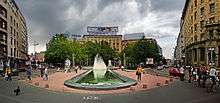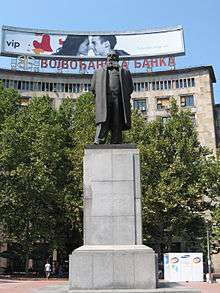Nikola Pašić Square

Nikola Pašić Square (Serbian: Трг Николе Пашића / Trg Nikole Pašića) is one of the central town squares and an urban neighborhoods of Belgrade, the capital of Serbia. The square is named after Nikola Pašić who served as mayor of Belgrade, prime minister of Serbia and prime minister of Yugoslavia. Until 1992 the square was named Square of Marx and Engels (Serbian: Трг Маркса и Енгелса, Trg Marksa i Engelsa).
Location
Located in the municipality of Stari Grad, Nikola Pašić Square lies in downtown Belgrade as the direct extension of Terazije. Named after Nikola Pašić, Serbia's famous early 20th century politician and Prime Minister, it overlooks the monumental building of the National Assembly and itself extends into Belgrade's longest street, King Alexander Boulevard, while Dečanska Street connects it to the Republic Square.
History and characteristics
The square was built during the 1950s as part of a massive Terazije reorganization project. Inaugurated as the Marx and Engels Square in honour of the famous communist theoreticians, its original terrain was so hilly that lots of earth had to be removed in order to make its construction possible.
Subsequently in the late 1980s, it was one of the Belgrade's first toponyms to change its name with the closing of the era of Socialist Yugoslavia.
Characteristics

A monument to Nikola Pašić was erected in the early 1990s. When the statue was to be erected, ideas of bringing back earth to the square in order to create the artificial hillock as a pedestal for the monument appeared, but were ultimately abandoned.
The dominant architectural features in the square are the massive, Socialist Classicism Dom sindikata (Trade Union Hall) building and one of the Belgrade's largest fountains. Museum of Yugoslav History is located across the fountain. Adjacent to the square is the Pionirski Park as well as the buildings of the Belgrade City Hall and the Presidency of the Republic.
The pedestrian section of the square is used for various public events, most notably open flower, honey, and book sales. On occasion, artificial ice rink or beach volley sand courts are put up as seasonal attractions in winter and summer, respectively.
Bezistan
Bezistan is a shopping area which makes indoor passage which connects the square and Terazije. Originally, it was a location of Hotel "Pariz", which was built in the 1870s and demolished in 1948 during the reconstruction of Terazije. Passage has been protected by the state as a "cultural property" and being nicknamed by the architects as the "belly button of Belgrade".[1] Since the 1950s, the covered square was a quiet corner in sole downtown, with mini gardens and coffee shops and a popular destination of many Belgraders, but in the recent decades mainly lost that function. Revitalization and reconstruction is projected for the second half of 2008. Objects within Bezistan include "Kozara" cinema, candy and souvenir shops, on one side, and modernistic section on other side, with "McDonalds" restaurant, modern coffee shop and "Reiffeisen bank". A fountain-monument under the semi-open dome is in the center. Bezistan is projected to be the central official souvenir shop of Belgrade after the reconstruction.
Birds
The most important species breeding at the location are Feral Pigeon, House Sparrow, Hooded Crow, European Kestrel and Common Swift. It is possible to hear songs of Great Tit and Woodpigeon from the nearby Pionirski park. Large gulls regularly fly over above the square at great height. [2]
References
- ↑ "Bezistan - Pepeljuga ili princeza", Politika (in Serbian), p. 23, 2008-03-26
- ↑ http://ebird.org/ebird/GuideMe?cmd=decisionPage&getLocations=hotspots&hotspots=L2213948&yr=all&m=
Coordinates: 44°48′45.7″N 20°27′46.6″E / 44.812694°N 20.462944°E
| Wikimedia Commons has media related to Nikola Pašić Square. |